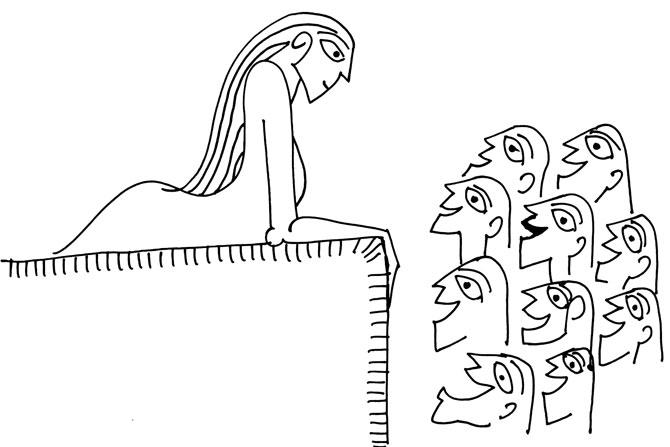A few months ago, I attended a fabulous Marathi show called Sangeet Bari that spoke about a little-known, yet widely prevalent, subculture of traditional singers and dancers in Maharashtra who perform only at private gatherings.

 A few months ago, I attended a fabulous Marathi show called Sangeet Bari that spoke about a little-known, yet widely prevalent, subculture of traditional singers and dancers in Maharashtra who perform only at private gatherings. It gave me a glimpse into the dancing halls of dancing girls, popularly known as 'nautch girls', would have been, before they were termed dirty, condemned by British colonisers and many puritan Hindus in the 19th and 20th century. It was in these private performing spaces that the arts flourished in India: Where song and dance was cultivated, way before the modern classification of folk, popular and classical. This was the world of the 'nat', the performer, a special kind: not one who was attached to a temple, not one who sought audiences like a migrant performer, but one who got audiences to seek him/her out. During the performance, the Sangit Bari performer said, “But we don't have audiences. We have customers!” And with that one sentence, I realised she was revealing one of the deepest secrets of Natya-Shastra, the Indian theory of performing arts that makes Indian performance art rather unique. She revealed the two-way relationship between the performer and audience, which is not just sensory, emotional or intellectual, but also commercial.
A few months ago, I attended a fabulous Marathi show called Sangeet Bari that spoke about a little-known, yet widely prevalent, subculture of traditional singers and dancers in Maharashtra who perform only at private gatherings. It gave me a glimpse into the dancing halls of dancing girls, popularly known as 'nautch girls', would have been, before they were termed dirty, condemned by British colonisers and many puritan Hindus in the 19th and 20th century. It was in these private performing spaces that the arts flourished in India: Where song and dance was cultivated, way before the modern classification of folk, popular and classical. This was the world of the 'nat', the performer, a special kind: not one who was attached to a temple, not one who sought audiences like a migrant performer, but one who got audiences to seek him/her out. During the performance, the Sangit Bari performer said, “But we don't have audiences. We have customers!” And with that one sentence, I realised she was revealing one of the deepest secrets of Natya-Shastra, the Indian theory of performing arts that makes Indian performance art rather unique. She revealed the two-way relationship between the performer and audience, which is not just sensory, emotional or intellectual, but also commercial.
ADVERTISEMENT

Illustration/Devdutt Pattanaik
I have noticed that a Western classical music or dance performance, the presence or absence of quality of audience makes no difference to the quality of the performance. It is 'one way'. But in an Indian classical music and dance performance, the artiste blooms as the audience responds to the performance. The artiste churns rasa (aesthetic juice) in the senses and the heart of the audience through the performance. She offers bhoga (food) to satisfy his craving. His attention and adulation contributes to the quality of the performance. Finally, he 'burps' in satisfaction. Then he pays her with appreciation, adulation, praise, and of course, money. A 'two-way' relationship is thus concluded.
The word 'customer' bothers us. When a dancing girl says 'customer', we automatically assume that she is a prostitute. An artiste can have audiences, not customer. An artiste strikes a commercial transaction with buyers, but somehow art is not seen as 'consumption' for a 'customer'. Art is made ethereal by differentiating 'commercial art' from 'pure art'. This is an outcome of Puritanism, a mixture of Victorian as well as Buddhist/Jain/Hindu monastic values, where money is seen as bad, a corrupting influence. Even worse is the idea that pleasure can be part of transactions.
Yet, pleasure is also a commodity that can be sold in the market. The performer exists to satisfy sensory, emotional, intellectual, and even physical, cravings of the audience. Which hunger is appropriate hunger? The performer not only satisfies hunger, but is also obliged to refine the taste of the consumer. Thus there are 'low' performers, who only give what the audience wants. There are 'high' performers, who also uplift the audience, making them crave not just more, but better quality. But how does the performer survive? Through payment! Patronage. Before the British introduced 'tickets' and the Americans introduced 'sponsorship', there was reward (bakshish), in exchange for a satisfactory artistic meal.
The principle of exchange, the completion of the circular loop, the two-way relationship, is also found in the rituals of yagna and puja. In yagna, the devata is invoked and given food to the chant of 'svaha' and the yajaman expects wish fulfillment to the chant of 'tathastu'. In puja, the devotee offers bhoga and expects the deity to give prasada. Likewise on stage, the performer needs to satisfy the customer to survive. The artiste is expected to survive somehow, thrive even, despite the dissatisfaction of the audience.
The author writes and lectures on relevance of mythology in modern times. Reach him at devdutt@devdutt.com
The views expressed in these columns are the individual's and don't represent those of the paper.
 Subscribe today by clicking the link and stay updated with the latest news!" Click here!
Subscribe today by clicking the link and stay updated with the latest news!" Click here!






